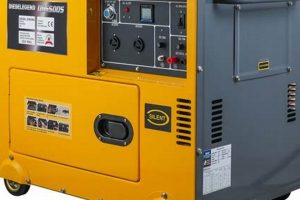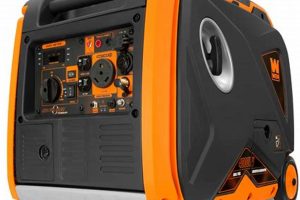Minimizing noise pollution from portable generators involves a multifaceted approach, encompassing strategic placement, sound-dampening enclosures, and regular maintenance. For instance, placing a generator on a soft surface like grass or rubber mats can significantly reduce vibrations and subsequent noise. Proper muffler maintenance and using high-quality fuel also contribute to quieter operation.
Effective noise reduction is crucial for maintaining peaceful environments, especially in residential areas, campsites, or during emergency power outages. Quieter operation improves community relations, prevents disturbance to wildlife, and allows for more comfortable use. Historically, noise levels from generators were a significant concern, prompting continuous advancements in noise-reduction technologies and strategies.
Several methods exist for achieving significant noise reduction. These include building sound-dampening enclosures, utilizing specific exhaust systems, and implementing advanced muffler designs. Exploring these options will provide a comprehensive understanding of the most suitable noise-reduction strategies for various applications.
Tips for Minimizing Portable Generator Noise
Several practical strategies can significantly reduce noise produced by portable generators, enhancing their usability and minimizing disturbances.
Tip 1: Strategic Placement: Positioning a generator away from reflective surfaces, such as walls and buildings, can prevent sound amplification. Placing the unit on a soft, absorbent surface like a rubber mat or thick grass further dampens vibrations.
Tip 2: Utilize Sound-Dampening Enclosures: Purpose-built enclosures or DIY solutions using sound-absorbing materials like plywood lined with acoustic foam can effectively contain noise.
Tip 3: Regular Maintenance: A well-maintained generator operates more efficiently and quietly. This includes regular oil changes, air filter cleaning, and spark plug replacements.
Tip 4: Quality Fuel: Using high-quality fuel formulated for generators contributes to cleaner and quieter combustion.
Tip 5: Proper Exhaust System: Ensuring the exhaust system is intact and free of leaks minimizes noise and ensures safe operation.
Tip 6: Consider an Inverter Generator: Inverter generators generally operate more quietly than conventional models due to their variable engine speed.
Tip 7: Distance and Barriers: Increasing the distance between the generator and noise-sensitive areas, and using barriers like bushes or fences, can further reduce noise levels.
Implementing these tips can significantly reduce generator noise, improving usability and minimizing disturbances to surrounding areas. These strategies contribute to a more peaceful and enjoyable environment.
By understanding the various factors that contribute to generator noise and implementing appropriate mitigation strategies, one can ensure efficient and considerate power generation.
1. Sound-Dampening Enclosures
Sound-dampening enclosures represent a highly effective method for minimizing noise generated by portable generators. These enclosures function by absorbing and containing sound waves produced by the generator’s engine and exhaust. Constructed from materials with high sound absorption coefficients, such as acoustic foam, mass-loaded vinyl, and specialized sound-dampening blankets, these enclosures create a barrier that significantly reduces noise pollution. The effectiveness of a sound-dampening enclosure is influenced by factors including material density, thickness, and overall construction quality. A well-designed enclosure can reduce noise levels by 10-30 decibels, transforming a disruptive noise source into a more manageable hum. Consider a construction site where generators power essential equipment. Utilizing sound-dampening enclosures enables operations to continue without excessive noise disturbing nearby residents or businesses.
Practical application of sound-dampening enclosures requires consideration of ventilation and accessibility. Enclosures must provide adequate ventilation to prevent overheating and ensure safe generator operation. Additionally, access points for refueling, maintenance, and control adjustments are essential. Pre-fabricated enclosures offer a convenient solution, often featuring integrated ventilation systems and access panels. Custom-built enclosures, while requiring more effort, offer greater flexibility in design and can be tailored to specific generator models and environmental conditions. For instance, in a residential setting, a custom-built enclosure can be aesthetically integrated into the landscape, minimizing visual impact while effectively reducing noise.
Sound-dampening enclosures provide a substantial benefit in noise reduction strategies for portable generators. Careful consideration of enclosure design, material selection, ventilation, and accessibility ensures optimal performance and safe operation. This method, combined with other noise reduction strategies, offers a comprehensive approach to minimizing noise pollution and promoting peaceful coexistence between power generation and surrounding environments. Addressing noise pollution through methods like sound-dampening enclosures contributes to improved quality of life and demonstrates a commitment to environmental responsibility.
2. Strategic Placement
Strategic placement plays a crucial role in minimizing noise pollution from portable generators. Optimizing generator location significantly influences sound propagation and overall noise levels. Careful consideration of surrounding terrain, reflective surfaces, and proximity to noise-sensitive areas is essential for effective noise reduction.
- Distance from Reflective Surfaces:
Positioning a generator away from walls, buildings, and other hard surfaces minimizes sound reflection and amplification. Sound waves reflect off these surfaces, increasing perceived noise levels. For example, placing a generator near a building can effectively double the perceived noise compared to placement in an open field. This principle is crucial for minimizing noise impact on surrounding environments.
- Soft Ground Placement:
Placing the generator on soft ground, such as grass or dirt, absorbs vibrations and reduces noise transmission. Hard surfaces like concrete or asphalt amplify vibrations, increasing noise. Using a rubber mat or other vibration-dampening material beneath the generator further minimizes noise transfer to the ground. This is particularly effective in reducing low-frequency noise.
- Elevation and Barriers:
Elevating the generator slightly can reduce ground-level noise propagation. Using natural barriers like bushes, trees, or earth mounds can further disrupt sound waves and reduce noise levels in specific directions. Strategically placing barriers between the generator and noise-sensitive areas maximizes noise reduction effectiveness. For example, positioning a generator behind a dense hedge can significantly reduce noise reaching a nearby residence.
- Wind Direction:
Considering prevailing wind direction helps direct noise away from sensitive areas. Positioning the generator downwind of residences or other noise-sensitive locations minimizes noise impact. This factor is especially important in open areas or during extended generator use.
By strategically considering these placement factors, one can significantly reduce noise pollution from portable generators. Combining strategic placement with other noise reduction methods, such as sound-dampening enclosures and proper maintenance, provides a comprehensive approach to minimizing noise and maximizing generator usability while minimizing environmental impact. This holistic approach ensures efficient and considerate power generation.
3. Regular Maintenance
Regular maintenance is crucial for minimizing noise pollution from portable generators. A well-maintained generator operates more efficiently, producing less noise and minimizing disturbances. Neglecting maintenance can lead to increased noise levels due to issues such as worn components, clogged air filters, and improper combustion.
- Lubrication
Proper lubrication ensures smooth engine operation, minimizing friction and reducing noise caused by moving parts. Regular oil changes, using the manufacturer’s recommended oil type and viscosity, are essential. For instance, using old or incorrect oil can increase friction, leading to louder operation and potential engine damage.
- Air Filter Cleaning/Replacement
A clean air filter allows for proper airflow to the engine, facilitating efficient combustion and reducing noise from the intake system. Clogged air filters restrict airflow, forcing the engine to work harder and produce more noise. Regular cleaning or replacement, as specified in the generator’s manual, maintains optimal airflow and minimizes noise.
- Spark Plug Maintenance
Spark plugs ignite the fuel-air mixture in the engine. Worn or fouled spark plugs can lead to incomplete combustion, resulting in increased noise and reduced efficiency. Regular inspection and replacement of spark plugs, according to the manufacturer’s recommendations, ensures efficient combustion and minimizes noise.
- Fuel System Cleaning
Clean fuel ensures proper combustion and minimizes noise from the engine. Stale or contaminated fuel can lead to rough running and increased noise levels. Regularly draining the fuel tank and using fuel stabilizers helps maintain fuel quality and prevents issues that can contribute to noise.
Implementing a regular maintenance schedule addresses these key areas, contributing significantly to quieter generator operation. Consistent maintenance not only reduces noise but also prolongs the generator’s lifespan and ensures reliable performance. This proactive approach represents a cost-effective and environmentally responsible strategy for maximizing generator usability while minimizing noise pollution.
4. High-Quality Fuel
Fuel quality plays a critical role in the noise output of a portable generator. Using high-quality fuel contributes significantly to quieter operation and overall performance. Substandard fuel can lead to inefficient combustion, resulting in increased noise levels and potential engine damage. This discussion explores the multifaceted connection between high-quality fuel and quieter generator operation.
- Clean Combustion
High-quality fuel, formulated specifically for generators, burns more cleanly and efficiently. This clean combustion minimizes the production of byproducts that can contribute to noise, such as unburnt fuel and excessive exhaust. The cleaner burn results in smoother engine operation and reduced noise from the exhaust system.
- Optimal Engine Performance
Generators operating on high-quality fuel experience optimized engine performance. This translates to smoother operation and reduced strain on engine components, which minimizes noise caused by vibrations and mechanical stress. For example, fuel with appropriate octane levels ensures proper ignition timing, preventing knocking and other noise-inducing combustion issues.
- Reduced Wear and Tear
Using high-quality fuel minimizes wear and tear on engine components. This contributes to quieter operation over the long term by preventing the development of mechanical issues that can increase noise levels. Clean fuel reduces deposits and corrosion within the engine, preserving its efficiency and quiet operation.
- Prevention of Carburetor Issues
High-quality fuel helps prevent carburetor clogging and other fuel system issues that can lead to increased noise. Clean fuel ensures smooth fuel delivery, optimizing combustion and minimizing noise from the carburetor and intake system. This prevents rough running and other noise-inducing problems.
Utilizing high-quality fuel is an essential factor in achieving quieter generator operation. The benefits of clean combustion, optimal engine performance, reduced wear and tear, and prevention of carburetor issues contribute significantly to minimizing noise pollution. In conjunction with other noise reduction strategies, high-quality fuel ensures efficient, reliable, and considerate power generation.
5. Muffler Upgrades
Muffler upgrades represent a significant avenue for noise reduction in portable generators. The muffler plays a crucial role in attenuating exhaust noise, a primary source of generator noise pollution. Standard mufflers often provide basic noise reduction, but upgrading to a performance muffler, specifically designed for quieter operation, can substantially decrease overall sound levels. This improvement stems from advanced internal designs that effectively dissipate sound energy. For example, some performance mufflers utilize absorptive materials and tuned chambers to cancel out specific frequencies, leading to a significant reduction in perceived noise.
The impact of a muffler upgrade is quantifiable. Depending on the design and quality of the new muffler, noise reductions of 5-10 decibels or more are achievable. This translates to a substantial decrease in perceived loudness, making generator operation significantly less intrusive. In a residential setting, this can be the difference between disturbing neighbors and peaceful coexistence. Furthermore, consider construction sites where generators often operate for extended periods. A muffler upgrade contributes significantly to a quieter working environment, benefitting both workers and the surrounding community. The practical significance of this upgrade becomes even more apparent in noise-sensitive environments such as campsites or during emergency power outages where minimizing disturbance is paramount.
Selecting the appropriate muffler upgrade requires careful consideration of generator specifications and intended usage. Factors such as muffler size, design, and backpressure compatibility with the generator’s engine are crucial. Incorrectly matched mufflers can negatively impact engine performance and potentially increase noise levels. Consulting manufacturer recommendations and seeking expert advice ensures optimal muffler selection and maximizes noise reduction benefits. Ultimately, investing in a high-quality muffler upgrade represents a cost-effective and efficient method for minimizing noise pollution and improving the overall usability of a portable generator. This upgrade contributes significantly to a quieter and more harmonious environment.
6. Inverter Generators
Inverter generators represent a significant advancement in portable power generation, offering a quieter and more fuel-efficient alternative to conventional generators. This advantage stems from their unique operational design. Unlike traditional generators that operate at a constant speed, inverter generators adjust engine speed based on power demand. This variable speed control significantly reduces noise output, especially during periods of lower power consumption. The engine operates only as fast as necessary to meet the required load, minimizing noise and fuel consumption. This fundamental difference distinguishes inverter generators as a key component in achieving quieter portable power generation.
The practical implications of this technology are substantial. Consider a campsite scenario: conventional generators often disrupt the tranquility of the environment with their constant drone. An inverter generator, however, seamlessly blends into the background, providing necessary power without excessive noise pollution. This distinction becomes even more critical in noise-sensitive environments such as residential areas or during emergency power outages. Furthermore, the variable speed control of inverter generators translates to significant fuel savings. The engine consumes less fuel when operating at lower speeds, reducing operating costs and environmental impact. This efficiency contributes to the overall value and practicality of inverter generators.
While inverter generators typically come at a higher initial cost compared to conventional models, the long-term benefits of quieter operation, fuel efficiency, and reduced environmental impact often outweigh the price difference. These benefits position inverter technology as a leading solution for those seeking the best way to minimize noise pollution from portable power generation. Choosing an inverter generator represents a commitment to both functionality and environmental responsibility. The integration of advanced technology provides a quieter, more efficient, and ultimately more sustainable approach to portable power.
Frequently Asked Questions
This FAQ section addresses common inquiries regarding noise reduction strategies for portable generators. Understanding these aspects is crucial for selecting and implementing the most effective noise mitigation techniques.
Question 1: How much noise reduction can one realistically expect from a sound-dampening enclosure?
Noise reduction from a sound-dampening enclosure varies depending on the enclosure’s design, materials, and the specific generator model. Reductions of 10-30 decibels are typical, representing a significant decrease in perceived loudness.
Question 2: Are DIY sound-dampening enclosures effective?
DIY enclosures can be effective if constructed properly using appropriate sound-absorbing materials and ensuring adequate ventilation. However, pre-fabricated enclosures often offer superior performance and convenience.
Question 3: Does strategic placement alone significantly reduce generator noise?
Strategic placement contributes significantly to noise reduction by minimizing sound reflection and directing noise away from sensitive areas. While effective on its own, combining placement strategies with other methods yields optimal results.
Question 4: How does fuel quality affect generator noise levels?
High-quality fuel promotes cleaner and more efficient combustion, resulting in smoother engine operation and reduced noise. Using low-quality fuel can lead to rough running and increased noise levels.
Question 5: Is a muffler upgrade worth the investment?
Muffler upgrades offer substantial noise reduction, often justifying the cost, especially in noise-sensitive environments. The improved noise levels contribute to a more peaceful and less disruptive operation.
Question 6: Are inverter generators significantly quieter than conventional generators?
Inverter generators generally operate much more quietly than conventional generators, especially at lower loads, due to their variable engine speed. This makes them ideal for noise-sensitive environments.
Addressing noise pollution through these strategies contributes significantly to a quieter and more considerate operation of portable generators. Implementing a combination of methods offers the most comprehensive approach to noise reduction.
For further information on specific noise reduction techniques, consult resources dedicated to portable generator operation and noise control.
Minimizing Portable Generator Noise
Effective noise reduction for portable generators requires a multifaceted approach encompassing strategic placement, utilization of sound-dampening enclosures, regular maintenance, high-quality fuel, muffler upgrades, and consideration of inverter generator technology. Each strategy contributes significantly to minimizing noise pollution; however, a comprehensive approach combining multiple methods yields the most substantial results. Prioritizing noise reduction ensures not only more peaceful operation but also promotes environmental responsibility and demonstrates consideration for surrounding communities and environments.
Minimizing noise pollution from portable generators benefits both individuals and communities. Adopting these strategies contributes to quieter, more peaceful environments, fostering positive community relations and preserving the tranquility of natural spaces. As technology continues to advance, further innovations in noise reduction techniques are anticipated, promising even quieter and more environmentally friendly portable power solutions. Embracing these advancements will be crucial for ensuring responsible and sustainable power generation in the future.






